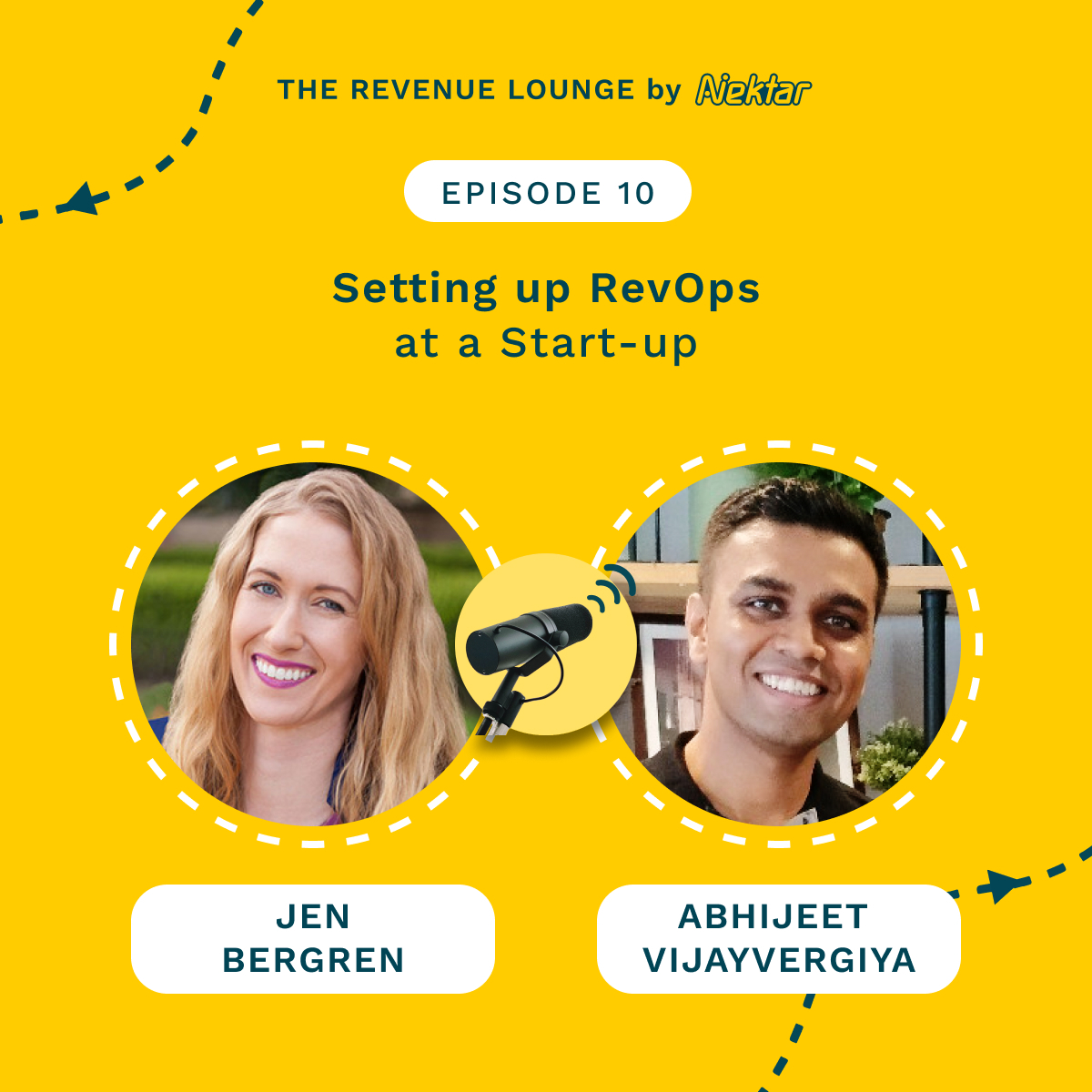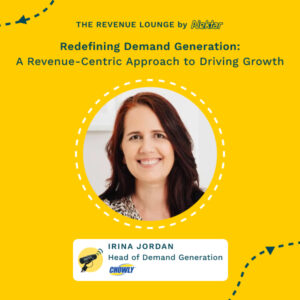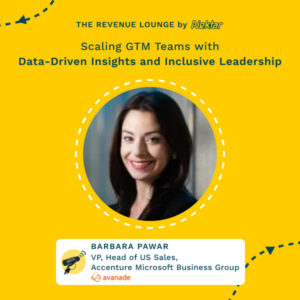Proactive Strategies for Growth Customer Success Engagement ft. Daniel Silverstein
October 16, 2024
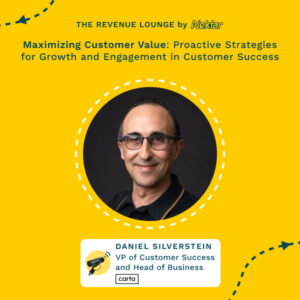
About
The Revenue Lounge
The podcast covers stories from leaders across RevOps, Sales, Customer Success, GTM, Data and Marketing about what drives these functions and what advice they would share with our listeners. With 3 seasons recorded, the podcast currently features 50+ enterprise leaders in the B2B SaaS domain. Tune in to hear from the best in the business
In this episode of The Revenue Lounge podcast, host Randy Likas interviews Daniel Silverstein, VP of Customer Success & Head of Business at Carta. They discuss how customer success teams can take a more proactive, strategic role in driving growth through customer engagement and uncovering new revenue opportunities.
Key Discussion Points:
– Evolving the customer success function from a reactive support role to a proactive driver of growth (00:00:05)
– Designing the organization and playbooks to be proactive with customer moments that matter (00:11:03)
– Identifying leading indicators of value delivery and churn risk without usage metrics (00:28:51)
– Segmenting the customer base for tiered engagement models (00:36:10)
– Keeping contacts and trigger data clean for effective outreach (00:41:17)
Guest Bios:
Daniel Silverstein – VP Customer Success & Head of Business at Carta. 15+ years of successful sales and account management experience specializing in motivating teams and developing revenue. At Carta since early 2019.
Carta – The leading provider of cap table management and valuation software for private companies. Carta helps companies and investors manage their cap tables, valuations, investments, and equity plans.
Key Quotes:
“If you know the life cycle and you get the engagement right, more often than not you’re gonna find an upsell opportunity.” (00:23:58)
“I’m a firm believer that the engagement is what matters, and it’s really hard to get it right and keep that in front of mind when you have revenue targets to hit.” (00:45:12)
“Be thinking through really critical fiscal lenses. We’re all gonna get put through the ringer here on what customer success is and what value it brings.” (00:48:16)

Randy Likas (00:02.619)
Customer success is more than just a support function. It’s a strategic pillar for growth. The challenge lies in how these teams can maximize customer engagement, foster key relationships, and uncover new revenue opportunities without losing sight of the customer’s needs. Hello, everyone. Welcome to the Revenue Lounge Podcast. I am your host, Randy Likas. And in today’s episode, we will dive into actionable strategies that help customer success teams take a more proactive approach role in accelerating growth and engagement, ensuring that revenue becomes a natural outcome of deep, meaningful relationships.
And joining me today is Daniel Silverstein. Daniel is the VP of Customer Success and Head of Business at Carta. With over 15 years of successful sales and account management experience, Daniel specializes in combining passion for motivating people with expertise in creating, developing, and growing revenue streams. Daniel, thank you so much for joining us today.
Daniel Silverstein (00:56.034)
Well, thanks for having me. Good to be here.
Randy Likas (00:58.267)
So, Jay, I’d like to start with just a little bit about you. So can you maybe tell us a little bit about your current role at Carta? And for those who might not know who Carta is, just a couple sentences on Carta’s business.
Daniel Silverstein (01:09.858)
Yeah, I’m happy to do that. Well, I’ll start with that first. Most people listening to this probably know either directly or in some adjacent way what Carta is. Carta is mostly known here in this, I think will change over time in the future as we build out our future strategy of what we’re working on here. But we are largely known as the CapTable Management Software Company.
In other words, we are the source of truth for equity ownership for the company level and for the shareholder level. So if you are a holder of equity, can track your holdings in there and exercise and understand the implications of exercising if you are the company who owns that cap table, so to speak.
you can administer equity and control all the outcomes of your cap table, including the dilution of the ownership of the cap table and the outcomes if you were to exit and move your business into a different direction. So we are the central source of truth for equity administration for private companies on the cap table side. So what I do here is I look after the post sales organization for that cap table part of our business. It’s about 30,000 customers.
That includes customer success, implementation, support. We have an in-house customer education enablement and strategy team, and then an operations team with our liquidity side of the business that runs tender offers and secondaries.
Randy Likas (02:25.691)
Fantastic and and you’ve been there close to five years Almost six years
Daniel Silverstein (02:28.431)
Actually over, almost six. Yeah, I started here at the beginning of 2019, so coming out of one six years.
Randy Likas (02:34.939)
Yeah, so in that six years, lots of changes in market dynamics and things that have happened, right? So maybe walk us through a little bit about how the customer success function has evolved over the past couple of years.
Daniel Silverstein (02:41.475)
Couple times, two or three times, yeah.
Daniel Silverstein (02:48.579)
Sure, yeah, happy to do that. Maybe it might be helpful, especially for this audience, to know that my background prior to Carta, a mixture of new business and existing business, kind of I’ve held the title Director of Sales multiple times in some of those places that’s included pre and post sales. So the challenge that I was brought here to sort of present and solve and create a workstream for was the post sales organization at Carta was five folks waiting for the phone to ring.
very reactionary, in some cases like, you know, solving a problem and maybe even selling them something, but not really knowing how to do it again and how to repeat it and make it a part of the everyday job here. So I was brought here to build the full sort of end-to-end post-sales strategy for the company, but also really in the eyes of who is now our CRO and our CFO at the time. Can you also get some more money?
Can you figure out how to do this in a way that is good for the customer and also good for Carta? So I was really spent the first year or almost two full years here building out that motion. How do you cover customers end to end from a segment perspective? How do you provide the right life cycle moments? And also how do you think about upselling expansion for what was seven or 8,000 customers at the time growing to where we are today at 30,000 or so? So trying to find the right life cycle engagement opportunities and building
while you’re growing, hitting revenue targets, carrying quota, trying to contribute to the company’s top line growth, while also figuring out ways to think about NDR retention and more bottom line, longer term strategies. So spent that first couple of years working on that problem alone.
Randy Likas (04:29.873)
Hmm.
Daniel Silverstein (04:30.953)
had a wild successful first year. We beat the quota by a million dollars in the first year, which got us, I would call, the investment opportunity to keep building more, getting more of the end-to-end, like how you think about how CSM and implementations and support interact with each other. And then eventually those functions came into my world as well. So I got the chance to sort of build more of a lifecycle-based motion across all the teams where we have handoffs between implementations and CSM, CSM and support,
support and secondaries and all the different life cycle moments that happen here.
Randy Likas (05:06.437)
That’s great. That’s certainly a lot of change has happened, In terms of what you’ve done, but the growth, right? As far as the customer growth. How do you organize your customer success function as far as segments and ownership of the revenue? And what I mean by that is certain people own the renewals, certain people do like account management through Farm for Growth. Like how does the organizational structure look?
Daniel Silverstein (05:13.625)
Mm-hmm.
Daniel Silverstein (05:32.355)
Yeah, we were, initially I would say it was more of what we would look like as a traditional account management function where we were, know, we were, all commercial stuff has always gone through our team. That has always been true.
We’ve always done renewals here, and so that’s always been a responsibility and probably will always be that way. It was a brief period of time where we experimented with a small renewals function and team, but it was really only for enterprise and it didn’t last very long. So I would say initially for the first three or four years, more like AM, commercial responsibility, upsell quotas.
and also retention at the same time, but really largely more of what you would think of as an AM function. Over the last couple of years, we moved into more of a CSM NDR focus, where the team is focusing more on the retention parts of NDR than the upsell. We introduced a growth account executive overlay team to sell into the install base, who we partner with. We do CSQLs and other things to generate revenue for them, but not directly selling. So we’ve done both. The way we segment our business here is based on
on the number of stakeholders, shareholders on a cap table. That’s how our contracts are set up. So you can sign a contract with us. You’re usually in a tier of one to 25, 25 to 50, et cetera, et cetera. And that’s how we price you. The package and features that you are sold into are relative to the actual size of your cap table. Renewal happens once a year. We snapshot your cap table. charge you based on where you are in those tiers. So one to 25 shareholders, if you will, is our S &P segment.
and is currently run by a team of folks in our Rio office and in Brazil. Our 26 to 300 is our mid-market segment and largely distributed across San Francisco, New York, some remote and some smaller offices and then 300 plus is our enterprise segment. And so it’s not the segments themselves, the naming convention pretty common. I would say it skews on the lower side relative to other companies because a
Daniel Silverstein (07:31.951)
26 shareholder company that’s in our mid-market book is still very much a small founder led company. Mid-market is by far our biggest segment. As you can tell, they’re where most of our customers sit. But it’s also where a lot of our customers have their maturity moment where they raise around and start to grow and take off and where their engagement with the product takes off and where they need us the most. So that’s by design that we have that segment so heavily skewed towards the mid-market part.
Randy Likas (07:37.702)
Yeah.
Randy Likas (07:59.397)
Great. And then are you moving towards a sort of the common motion? We see a lot of companies moving at the SMB segment of like more of a a scaled model or a digital model where instead of having one one relationships like there maybe is a pool or something like that. How does that work?
Daniel Silverstein (08:08.941)
Mm-hmm.
Daniel Silverstein (08:13.935)
Yeah, we’ve done that a couple different ways. let me start by saying we’ve always had to take that approach to some degree.
the size of our install base next to the revenue that comes along with it, it’s a low ACV product. And it’s great. If you ever use Carta, again, from either side of the business as an administrator or as a shareholder, or if you are in our fund administration side of our business and use the software over there, I think it’s very clear that we have incredibly strong product market fit. We’ve built a very well-designed, lifecycle-based business. But the challenge with it is it doesn’t become daily use until you get to enterprise.
And so we don’t, and it’s next to other software tools in your stack, it’s probably one of the least expensive. And because it is such a low ACV, not high transaction, but just low ACV and but high volume of customers. We’ve always had to take a scaled approach. We have done digital things here for years. We will always have to do them SMB and mid market. Just we have thousands of customers for every CSM that’s in the book today. So we’ve been engaging on that level for quite a while.
We’ve used technology to help us with that over the years. We started with your sort of basic spreadsheet to Salesforce and then Salesforce to Catalyst and then using Catalyst again today. But we’ve had to find, and I say this a lot to people, like…
understand the moments that happen to your customer really well. The technology can help you to some degree, but if you don’t know the moments, it doesn’t matter whether you use technology or nothing, you’re going to miss. So we’ve had to use that skilled approach for a very long time. And we continue to. Outside of enterprise, it will be the reason that we succeed or fail is knowing those moments, knowing what happens once a year, once a quarter, twice a year, what the venture-backed looks like, because we are one. We’ve modeled it after ourselves.
Randy Likas (09:57.319)
Mm-hmm.
Daniel Silverstein (10:07.885)
We know those things that happen and we use the technology to help us scale programs where our intent is to get there right before the moment happens and give some education that, you again, if you do it right, it leads to revenue, either now or in the future. I have no preference between the two of them, even when we were.
directly responsible for upselling, my perspective is like, you get the sale when the sale’s there. If you do the engagement right, it will come to you when the time is right. But it’s all about those moments and getting, going through your product, understanding in a non-daily use way, which is a very hard constraint to work with. You don’t get to work with the things that some digital SaaS companies have at their advantage, where you see logins and things that happen. MAU, like we don’t…
Randy Likas (10:36.123)
Mm-hmm.
Daniel Silverstein (10:53.581)
We can’t operate with those metrics well here. So you have to really dig in and understand behaviorally what a life cycle is, get ahead of it, and use the technology to help you scale and get communication out to larger swaths of customers ahead of something that’s about to happen. And if you engage with them right, they recognize you understand the business, you build relationships, and over time, the opportunity for them to, when they go raise around and start hiring and need something more from you, it comes back into you more like an inbound motion.
Randy Likas (11:23.355)
Yeah, so I want to dig into a little bit more because I think a lot of customer success teams are often seen as being reactive, right? And I would like to dig into what you’re talking about, like the moments that matter, understanding that the venture-backed of customer lifecycle in order to be more proactive and really to try to drive growth. maybe talk a bit more about how do you design your organization to be proactive and what are some examples of those moments that matter in your business that
Daniel Silverstein (11:42.926)
Hmm?
Daniel Silverstein (11:52.365)
Yeah, sure. I’ll give you a couple of examples of that. We’ve done a lot of the work for our teams here in many ways. It’s not that we don’t… We farm lots of ideas from our ICs and managers across the organization. We always will. That will always be part of it. But what I did when I got here was very much try to start to tee them up.
Randy Likas (11:53.223)
your team could use.
Daniel Silverstein (12:13.975)
Some of them were what you would consider to be like more traditional upsell motions like customer A and customer B look like each other. There’s two ways they should have the same features. Try to sell customer B what customer A has. But I really, what we did was we started to think about like what are the implications of not having B in their success as a business? Not whether they should buy it not because on paper they look like somebody should have it. If you haven’t bought 49A and you’re not using as for 49A.
Do you have a current FMV on file or no current FMV on file? If you don’t have a current FMV on file, are you actually issuing securities or not issuing securities? You start to create these sort of matrix correlation things to the two of them and you realize really quickly some of these companies are hurting and maybe have not raised money and are in a position where they might need something else from us. But some of them have just bought something and not used it.
So you can go into like, you know, understanding how to get somebody back on track for something that they should be doing that they haven’t. So some of those things are, and those are not new, common, like new, wildly controversial or interesting ways to do things. But what we have done is start to think about earlier stage companies, things like you create a new share class in the platform, you start creating draft issuances, doing things that are like modeling what could look like something is about to happen.
recognizing what those things are in the right sort of appropriate way, reaching out to suggest that you like, somebody might be growing and about to do something. How can we help you? How can you think about the next thing that you’re going to do? What else should you be doing after that next thing happens that you don’t know now? So you can start place holding future conversations pre and post event in that way. like, know, the share classification is a very common one that we use early. It’s usually a very clear sign that somebody is about to make a change to their cap table.
we’re aware of that, we reach out, we engage. As you get later in the life cycle, and this one we figured out a while ago was like, we’ve moved into a multi-product world, we built a compensation product on top of our cap table software, we started selling into a new persona, which would be like, usually we’re in the office of finance, the CFO, we moved into the people team, the people ops and HR, need to figure out how to sell and think about behavior that’s happening in a different world there.
Daniel Silverstein (14:32.633)
What we started tracking against was changes in company admins that happened under certain circumstances where you might think this is indicating they’re going to do something next. In that case, for total compensation, somebody comes in, you think they’re on a planning cycle, they might be.
interested in thinking about a solution for that that they weren’t thinking about before or if it’s a later stage company who adds a new CFO to the company admin page, triggering sort of introduction and like a whole series of education things that a late stage private company should know that they don’t know. Sometimes it’s not good. Sometimes this is not new in software. Somebody changes, you lose your champion, you lose your company admin, you lose your advocate.
Randy Likas (15:06.929)
Hmm.
Daniel Silverstein (15:16.023)
Sometimes that comes under circumstances that are not necessarily gonna be a good outcome. But the quicker you know about them and the quicker you take action on them, you know what the potential things are that could be discussed at that moment in time. It’s not a like, please let’s talk and buy something or, hey, your renewal is coming up or like, let’s talk about why you didn’t do X, Y and Z. It’s a education opportunity. Welcome into this ecosystem.
You either have been in this ecosystem before with different lenses and know this and just are thinking about it through a different company lens, or you are new to this ecosystem, you really don’t know what you don’t know. Let me give you a full, this is what you should be thinking about as a series C company that just came in, Decarta. We recognize what you’ve already done on the platform, what we think companies in that stage should be concerned about a year from now, two years from now, three years from now.
helping you think about the end of your life cycle now rather than thinking about that six months before it happens.
Randy Likas (16:13.617)
Yeah, well, that’s great. And it sounds like you’re, like, it’s almost as if you’re advising your clients on what they need to know before they even need to know it. Right. Yeah.
Daniel Silverstein (16:22.895)
If we’re doing it right, that’s exactly right, absolutely. And it is hard because at that scale of customers with a smaller CSM team than you would think for a company of install base of that size, you’re certainly gonna miss. So the moments of why it matters and that’s why the scale technology helps is that we can take a scaled approach here and be right 80 % of the time on one of these things that’s gonna happen.
you know, for some of the other parts of the organizations that are looking for upsell opportunities, we can get the triggers right on those things. But the real important point today, I think that you just made there is like, if we’re doing this right, we are leaving you with something you didn’t know before, and we are helping you plan using this, this software tool. If we’re doing it wrong, the transaction’s already happened. And you know, it does happen at 20 % of our install base. They don’t engage for whatever reason.
In some of those cases when, as an example, a company admin changes, they come in, they replace it with somebody who has used another tool, that’s also common in the software world, to see that stuff happen. So we won’t get it right 100 % of the time, but our goal is really to try to get it right more often than we don’t, and to leave our customers with some sense of like, hey, I wanted to talk to an equity professional, if you will, not tax advice equity professional necessarily, but like…
How do I think about the things that I need to do as a venture-backed company with the people who know more about it than anybody else? If I didn’t leave the customer with that experience afterwards, then we had an opportunity to do better.
Randy Likas (17:51.367)
So let me ask you question about that because I think, and I don’t know if this is true, but I’m going to make a hypothesis here that the different personas that your team engages with is probably different than maybe like an initial land, right? In initial land, you might be dealing with like the CFO and some of the executives and maybe the controller, maybe some people at some senior levels. And then once they come on board,
Daniel Silverstein (18:15.256)
Hmm?
Randy Likas (18:18.447)
They delegate that down to an admin of some sort, and that’s kind of who your CSMs are, primarily working with day-to-day, week-to-week, month-to-month. And so, as you think about how you make sure that you deliver that right content to the right persona, it can be difficult when we don’t have that engagement with those personas that have changed sort of in the post-sale. Am I accurate here? Is this challenge that you’re facing as well?
Daniel Silverstein (18:28.025)
Mm-hmm.
Daniel Silverstein (18:34.456)
Mm-hmm.
Daniel Silverstein (18:40.64)
Yeah, absolutely. 100%. And it’s funny because in some ways, if you think about our, because we have this life cycle business that technically in lot of ways has a beginning, a middle and an end. Many companies at the beginning don’t raise money in SMB and don’t make it at all. But you have this sort of like, you know, two guys in a garage IPO on two ends of the spectrum, right? The two guys in the garage, might be two guys and might have like a CEO, co-founder, CTO.
titles where you’re talking to the two guys who both wear all the C-level hats and then as they go graduate through the life cycle and to your point start to hire and delegate down you in the middle of our book where most of our customers live you’re probably talking to a controller or like a stock plan admin or somebody of that nature who is a functional owner and power user of the product but not a decision maker at all.
And then as you get later, it kind of flips back up. You start moving back up the ladder because the implications of the actions that they’re taking as a business and what they use our platform for are closer to a material event of an exit and they start paying more attention. So you go back to talking to a VP level plus and if it’s a liquidity event or something like that, then you are talking to the CFO again. So it’s like.
CFO over here, CFO over there, never in the middle, Except for like a biotech company who’s growing very fast. So yeah, we do. That changes quite a bit. you really, it actually relates to the conversation about life cycle that I’ve mentioned earlier, which is that…
Randy Likas (19:57.575)
Thank
Daniel Silverstein (20:09.901)
recognizing who your persona would be for SMB in 1-25 and what you look like pre-seried seed versus post-series seed, what everything looks like post-series A. When you start to get that first big batch of hires, this one, we first built our total compensation tool and started selling into companies that were rapidly hiring and growing. You probably didn’t have an HRS connected to your platform to care about this problem until you raised a bunch of people, you had a bunch of new hires, which you know, series A is a
Randy Likas (20:18.821)
Okay.
Daniel Silverstein (20:39.824)
big moment for a lot of companies in that world where they hire batches of 50 plus people. So yeah, we do have to track the persona carefully. This is something we’ve worked on with marketing for years, trying to make sure we understand that persona changes over the course of a life cycle. And part of that concept of having like trigger notification of change in company admins and things of that nature does matter around material events, but it also matters just to understand like to make sure we are talking to the right person.
Randy Likas (21:07.045)
Mm-hmm.
Daniel Silverstein (21:07.161)
and then we’re spending our time with the right level person, bringing that level of education to that right level person. We have a community platform. We wanna make sure we introduce people to the right community forum to talk to other people like each other, but you have to know which persona you’re talking to. So I would say we have a pretty good grasp on where those things sit typically. We have enough of a data set at this point.
Randy Likas (21:13.21)
Yep.
Daniel Silverstein (21:29.647)
having done this for as long as we have, that we can pretty well know if it’s a series C- company, who you’re probably going to be talking to. If it’s the founder persona, we know how to do that well. As matter of fact, we actually call our SMB segment the Founder Success Team for that reason. We were very aware of what founder journey looks like versus mid-market and beyond. So that is a very accurate observation.
Randy Likas (21:46.683)
Hmm. Mm-hmm.
Randy Likas (21:55.535)
And so then your moments that matter, right? I think there’s ones that where we go, here’s an opportunity for us to service the customer to help educate, I would say more on the educational side. And there’s the ones where it’s like, that might be ripe for a cross-sell or an upsell opportunity, right? So how do you, guess the question would be like, what strategies do you put in place to identify like those upsell or cross-sell opportunities? Does it differ? I guess it’s because you understand
Daniel Silverstein (21:58.425)
Mm-hmm.
Daniel Silverstein (22:09.091)
Mm-hmm.
Daniel Silverstein (22:21.442)
Hmm? Yeah.
Randy Likas (22:24.539)
that life cycle, you know which ones are the upsell or the cross-sell. Maybe a little bit more about how your team thinks about that.
Daniel Silverstein (22:29.849)
Sure. Yeah, so I mean, I think there’s some places where they are the same. And I say this often, and I really do believe, you know, as somebody who’s done, you know, like pre-sales, post-sales in my career, I do think if you’re doing it right, they are mostly the same.
If you know the life cycle, and I’ve said this many times also, I think the revenue is the result of the engagement, it’s not the purpose of it. If you’re doing it wrong, you can treat this like any other new business cycle of at bats and number of emails it takes to get an opportunity. And we’ve had to do that too, to drive revenue. are still a growing company that needs to drive more top line revenue growth. We still do that now.
But I would argue that to some degree, the events are the events. And whether it’s an upsell or not, if you do it right, the money will come in. We also have, in Accarda, this is an advantage of ours, as building this product that we built here, we have compliance-driven products, which a lot of SaaS companies have some version of that. We know what the implications of not doing something are. We know what happens when you get to a certain stage and you should be thinking about
stock-based compensation reporting. And when we get to that window, and we know something again, back to education, we know something you don’t know. Hey, you’re 75 shareholder company, you’re probably not audited yet, but you’re going to be audited.
Randy Likas (23:48.728)
Mm-hmm.
Daniel Silverstein (23:48.919)
And when you get, when you become, enter that stage of your life cycle, it’s gonna be like not an option whether you have a software to help you with this. You’re not gonna wanna be doing this through Excel or through a law firm or somewhere else. Like this is the place to do what you need to do. And so when you hit those compliance hurdles and sort of like life cycle moments, we’re very clear, hey, we’re advising you, but also you gotta buy this. Like, and those moments actually are fairly easy in that way. Like when we hit the compliance trigger moments, they’re good, they’re.
Randy Likas (23:56.912)
Yeah.
Daniel Silverstein (24:18.199)
It’s pretty clear, especially when you get ahead of that moment, they tell them something they didn’t know, it provides sort of a detailed expectation of not just what the software will do, but what audit defensibility means if you buy this software tool through us versus trying to do this yourself. You start to hit on the right pain sensitivity, the timeline, it’s very easy, you’re more than likely talking to the person who’s going to feel the pain the most if it goes one way the other.
Randy Likas (24:31.786)
huh.
Daniel Silverstein (24:46.39)
It’s a beautiful thing when you have compliance products because you have this sort of like pre-moment pain, during the moment pain, post-moment pain, where all those things technically would fit the category of when somebody would want to buy something from you. But it is very much about the moments and even the cross-sell products that we built here, our CARTA total compensation tool.
Randy Likas (24:55.249)
Right.
Randy Likas (25:01.254)
Yeah.
Daniel Silverstein (25:10.232)
We’ve built an equity advisory product and service that we use around like tender offers and things of that nature where you as a shareholder, you probably have lots of questions about exercising and wanting to talk to a tax professional. We built that into the motion as well. So I would say like it is a mixture of things where if you have the moments right and the engagement right, more often than not, you’re gonna find an upsell opportunity. And what I’ve coached the teams on here forever is like,
Randy Likas (25:32.38)
Yeah.
Daniel Silverstein (25:39.597)
Just because you get to the moment faster doesn’t mean you’re gonna get the revenue faster. And you shouldn’t conflate the two things. If you get to the moment at the right time, right at the right time, every once in a while, sure, you’re gonna get it. But if you get to the moment early, then ideally you have told somebody something they should be planning for, and then you’re not worrying about budget for an upsell either, because you’ve planted the seed with them ahead of the moment, sometimes three to six months before the moment happens.
Randy Likas (26:01.361)
Thank
Daniel Silverstein (26:07.224)
that when the moment happens and you’re talking about a relatively low dollar amount of an upsell here at Carta, it’s not a massive ACV increase, but you’re talking about something that they no longer have to budget for because they knew about it six months ago. You’re not trying to get to them right at the moment that it happens when they’re like, crap, I gotta buy this thing, I don’t budget for it, my boss is gonna kill me. You wanna help them, help themselves. And so really I do think the engagement is the point in getting that right.
Randy Likas (26:19.068)
Right.
Randy Likas (26:28.678)
Yeah.
Daniel Silverstein (26:34.657)
a couple of clicks ahead of whatever is gonna happen next. The revenue comes back in when it needs to and when it naturally settles. We have some people on our team here from the early days that are still here. Actually, one of them is a senior manager on the team, another one of them is on our enterprise team. The, like, build a pipeline in the first couple years was fascinating to watch, the two of them. And their philosophy was, like, I’m just gonna take every single conversation somebody will give me.
Randy Likas (26:37.326)
Yeah.
Daniel Silverstein (27:02.794)
I don’t care what it is, one of the guys actually was in our Utah office at the time where a lot of our support teams sit. And if he didn’t understand what something meant, he would just walk over to the support team and ask them, hey, this customer just said this, tell the customer, hold on a second, walk over to the support team. Hey, what does that mean? Hey, I got an answer for you. They just took every call they could get. Some of them hard, some of terrible, some of them like, you
Randy Likas (27:20.636)
Yeah.
Daniel Silverstein (27:24.463)
just getting yelled at for whatever reason. But they built this report, understanding of their customer’s life cycle and trust and engagement. And all of a sudden I looked down and the summer of 2019, I remember one moment, it’s just like these two guys were like, Forex pipelined everybody else. And it was very clear to me all of a sudden, it was like, well, you guys are getting this engagement thing right.
Randy Likas (27:45.381)
Mm-hmm.
Daniel Silverstein (27:45.858)
You’re not building pipeline intentionally, you’re building pipeline through a relationship and understanding your customer moments. And every one of these conversations is a notch on your belt of your further understanding of a life cycle. And then they helped us build the playbook triggers and the things that we use for everybody else now. And that motion and model, I think is what makes people successful.
Randy Likas (27:49.948)
Yep.
Randy Likas (27:56.293)
Yep.
Daniel Silverstein (28:05.518)
is thinking about pipeline for an upsell, for cross-sell, not as like, what is that buying moment or even do you have in the right, like, know, are you thinking about the buying trigger in the right way? It’s like, did you get to that moment three months before the buying trigger happened? Because if you did, there’s a pretty good chance that if you educated them on it, when they’re ready, they’ll come to you.
Randy Likas (28:09.254)
Yep.
Randy Likas (28:25.766)
Where is the source of truth for a lot of this engagement that happens? Is it within your catalyst platform? Is it Salesforce? What systems do your… I guess that was the first question. Part two of that question would be, if you look at the different sources of information that can help us identify these triggers, where do those come from?
Daniel Silverstein (28:48.783)
Yeah, they come out of our product. They come directly out of our product. And what we did in 2020, early 2020 was it was very clear to me that the Salesforce integration through our platform was not going to be strong enough to get this done. And also, again, not controversial, but Salesforce by itself as a standalone for post sales teams, maybe not the most effective thing. So we bought Catalyst in early 2020, set up an Amazon S3 bucket, started passing stuff through.
Carta back end administration threw the S3 bucket into Catalyst, run a bunch of playbook triggers off that. We used Catalyst for a couple of years. We grew pretty fast. We moved over to Tango. We were there for a couple of years, came back to Catalyst and then the two of them merged. Now we’ve got all of them. Sounds like best of both worlds. It is. I’m very fond of both those products. I know the founders on both sides of that very well. by and large, the source of truth for what we take action on.
Randy Likas (29:32.742)
I
Daniel Silverstein (29:47.79)
And the source is Carta backend. The tool that we use to resource that is all coming out of Catalyst. So we’ve run all these playbook triggers out of Catalyst. Catalyst now allows us to, and this is very helpful for us as a scale team. One of the things that wasn’t true in 2020 that is today is that it triggers emails itself out of the platform.
You can run the whole logic tree out of Catalyst itself. You create the moment, it hits the trigger, the emails themselves run through Catalyst, the tasks that go to the CSM come out of there as well. So all of our data moments that happen, we pull the right moments and we have a long running list that we use, that we started with probably in 2020 and is now much, much, much longer that goes through our data team and they add it to the S3 bucket, passes through into Catalyst.
Randy Likas (30:18.854)
Yeah.
Randy Likas (30:33.553)
Yeah. Yeah, interesting. Your business is very interesting because I don’t think a lot of the traditional B2B SaaS metrics that maybe a customer success organization could use like product adoption or consumption, like that really doesn’t apply so much in your model. So like, I’m just curious, like what are some of the leading indicators that show, you know, we are mitigating churn or we’re delivering value to the customer that…
Daniel Silverstein (31:01.496)
Mm-hmm.
Randy Likas (31:02.043)
maybe you don’t have available to you because it’s just the nature of the way your business is.
Daniel Silverstein (31:06.446)
Yeah, so I mean, you’re 100 % right. And I think to some degree for a while at the very beginning it was hard. thought about these things like, you know, it’s gone back and forth between being an opportunity and a handicap. It depends how you look at it. I think it’s in my mind, it forces me to continue to be creative and thinking about things that maybe are a little bit easier. Software tools like Catalyst and Tatango and the other ones that are out there in the world of Gainsight for that matter. If you do have those…
like a more robust.
traditional SaaS business, you can rely on those adoption metrics like that. I mean, you could set up things that I can’t do at all here. So it’s interesting. We have, let put it this way. We are now for the last couple of years have been very much an NDR focused organization. And I say NDR because certainly gross churn is part of that. But net result is what we care about. It’s the thing that our board cares the most about. it’s what collectively, whether we are directly upselling or responsible for CSQLs.
or not, like, you know, it’s all NDR to me, it’s all the customer experience, keeping the revenue growing that matters to me. And one of the ways that we’ve thought about churn reduction in the last couple of years and retention as a like an outcome, as those levers of NDR during an economic downturn, is thinking about like, you know, the controls that we have around commercial interactions, things like discounting, things like
you know, price, introducing price increasing initiatives and escalators, things that affect the dollars. But in terms of like the actual like leading indicators and KPIs that we think about, a lot of times these are like broader, I mentioned this earlier, but like a matrix of combination of product adoption things that hit each other at the same time that are usually an indicator that something we need to be talking to somebody about something in our cap table platform. We do have this like.
Randy Likas (32:50.991)
Yeah.
Daniel Silverstein (32:58.166)
security is accepted in issuance concept here where like if you’re not issuing as a company, there’s a
a reasonable chance that you’re not raising and probably not growing. If you’re not accepting on the holder level, there’s a reasonable chance that the program itself is not successful internally. If you have this combination of accepted and sent as a leading indicator for something, 490 is one we use often here. Like if you’re keeping yourself compliant and have an FMU file every year, we understand that you’re an active company. you have a 490 subscription with us, you’re not using it. Like there are very broad
Randy Likas (33:07.217)
Yup.
Daniel Silverstein (33:33.569)
stroke products adoption things that if combined with each other, we think are indicators that we should be talking to you. Sometimes it’s about adoption itself, like you’re not using this tool, you’re not in compliance, you need to use it. Sometimes it’s you’re not using this, maybe you churned. You’re not using both of these things at the same time and you haven’t for six months, there’s a pretty good chance you ran out of money and we probably should send a different type of message to this customer that’s sensitive in a different way.
Randy Likas (33:36.476)
Okay.
Randy Likas (33:59.793)
Mm-hmm.
Daniel Silverstein (34:00.238)
And then as we start moving further up market, we get into a little bit more like traditional product adoption metrics, things that are more related to what we’ve surfaced, what we call health checks here. There are like, you know, there’s probably hundreds of them in the world, but the ones that we care about the most are like the top 15 that keep your cap table ready for a transaction. So we use those as leading indicators. If you’re doing, if you’re keeping these 15 health checks in order, there’s a reasonable chance that you’re probably thinking about a transaction, a big one.
Randy Likas (34:29.317)
Uh-huh.
Daniel Silverstein (34:29.454)
How do we think about like things like, you know, keeping your HRS connected and keeping your cap table correct as it relates to your HRS and like stakeholder addresses and all those things that matter are connected to each other. Those are probably also you keep those up to date when you’re getting ready to run a transaction. So we do have some version of that today, but ours ends up being either like a major combination of things of like a, you know, we know what this probably means.
Randy Likas (34:43.6)
Yeah.
Daniel Silverstein (34:58.606)
we’re going to use this type of outreach. And if we think it’s a bad outcome, because churn is a part of our business that sometimes we can’t control, overwhelmingly we’re talking dissolution, &A, and IPO are drivers, the biggest drivers of churn for us. If dissolution is one that we can identify, we can treat those customers in a different way. It doesn’t mean we don’t treat them. It means we treat them in a different way. hit leading indicator that means, we think means, you’re out of money.
Randy Likas (35:05.605)
Mm-hmm.
Randy Likas (35:12.358)
Yep.
Daniel Silverstein (35:24.264)
or you might be running out of money, we’re going to reach out to you and talk about something different. If we think you’re doing something behavioral in the product that looks like you’re cleaning up and getting ready, maybe you need help with the cleanup. And we can help you clean that up. But we have to think about those things as like combinations of things that happen concurrently or sequentially as opposed to just standalone. Like this company had this many active users that spent this much time in the product. we don’t, those things are not useful for us. If anything, I remember talking once.
Randy Likas (35:34.981)
Hmm.
Randy Likas (35:50.79)
Yeah.
Daniel Silverstein (35:53.226)
Ironically, I think it was actually one of the co-founders of one of our vendors who oftentimes their customers, of course, right? My introduction call with this individual, I was on a call and I think he said to me, he’s like, hey, you know, before we like get into this whole thing about us working together, vendor relationship stuff, he’s like, can I give you some feedback about Carta? And I was like, sure, love to hear it. He’s like, I love your product. He’s like, but you don’t get me to use it enough. And he’s like, when I get in there,
super easy, like I get what I need and I get out of there, but it’s like, you don’t get me to use it often enough. And I said, I was like, know, feature a bug. Like, do you want to use it more? Is there more that we can do to educate you on things that you don’t know about, or is this just like right on time for you? Because there’s ways to think about that answer that are different for each customer. And it’s okay, actually, if the answer for a lot of our customers is right on time. When you need it, it’s there.
Randy Likas (36:47.878)
Yeah.
Daniel Silverstein (36:49.932)
the people that you need to support it or have given you what you need to educate yourself right before it. If something happens right after you know how to get ahold of your CSM, our support team is amazing. Those things can also be true and be fine, but it always hits you when you’re like, wow, somebody said that to a founder of this company, said this to me. We’re doing something wrong. We gotta get this right. We gotta get them drawn into the platform and brought them in there. But when you’re looking at the actions they need to take, it’s like, we could probably actually help educate you without getting you to log in.
Randy Likas (37:00.604)
Mm-hmm.
Randy Likas (37:18.885)
Right, exactly. And it goes back to like, is this a sample size of one that might be okay, maybe it’s an insight, but does that, is he or she a unique outlier compared to the rest of the person?
Daniel Silverstein (37:30.934)
Yeah, we’ve had to like really pile these things up over the years and I’ve been fortunate enough.
especially with my leadership team here, a lot of the folks in my organization who run the implementations and support and CSM functions, some of them have been here longer than I have. My senior director runs the CS function under me, has been here working with me now for over five years. We’ve worked for these things together. And again, it’s nice being a venture-backed company who runs that similar life cycle. We can use our own experience to understand what would a series E company, what would they need and why.
versus when I started here and where our CFO was probably still a user of Carta. Not true anymore, right? Yeah.
Randy Likas (38:14.919)
So to build on something you just said, which is like, we kind of look at these matrix of signals or matrix of triggers. And then earlier in the conversation, we talked about like, because you’ve got 30,000 customers and you only got so many CSMs that can support that, there’s gotta be a, how do you, I guess the question is, you probably look at certain triggers or things that happen that require an in-person white glove touch as opposed to a digital touch, right? So somebody running out of money.
Daniel Silverstein (38:39.16)
Yep. Yep. Yep.
Randy Likas (38:42.501)
You know, we probably don’t want to set up a digital communication on that. We probably want to have conversation. So how does that feed into the playbook that you’ve designed as far as knowing when do we apply the white glove service as opposed to the digital touch?
Daniel Silverstein (38:53.486)
Yeah, so one of the things that we did, and I say this sometimes, like it sounds worse than I mean it, like we’re always in a position to have to scale non-linearly here, and head count capacity specifically will probably always be a constraint for us. I’m aware of what it is, it will always be that way. We’ll never be able to do white gloves across 90 % of our install base. With that in mind, what we did this last year, and I think we’re still trying to optimize this as best as we possibly can, we’ve taken mid-market as an example.
where the mid-market CSM most likely in their named accounts has 13, 1400 accounts. Okay, so we’re talking very scaled. We have identified within those books, sort of high medium, low touch customers, the high and medium, we take stuff that we have access to here, which is, you know, not sensitive or controversial information, but it’s only the stuff that we would understand like year over year valuation growth.
stakeholder growth, time since last fundraising round. Like we look at all these things and combine them and say like this company and also then map it against WalletShare. Like if these three or four things are true and you also haven’t bought every software tool that’s available to a mid-market customer, you’re probably a high touch customer. Mark them, stamp them, run Playbooks against it. Medium is like…
Randy Likas (40:07.323)
Hmm. Yep. Yep.
Daniel Silverstein (40:12.014)
You made three out of the four and last raise was this amount of time. We created a set of criteria and we mark and stamp them, we run playbooks off of them. So you’re a mid-market CSM, you now have 400 combined high and medium touch customers that we try to engage with, especially high touch customers. Those are EVR candidates, we should be doing EVRs with them. They still have not planned their exit, they’re still growing, there’s still opportunity to think about things that they should be buying, but also more importantly, like…
they are probably still tentatively thinking about what Carta can provide them that would help them. And they’re still growing, they’re not running out of cash, they’re still in a position where the growth mindset’s still part of the discussion. So we market stamp them and let them run. In the background, there’s a much more proactive white glove experience that comes from being a high touch mid-market customer than tech touch at the bottom. The tech touch ones, we let them run. We have digital engagement out there, lots of inbound stuff comes in from those customers.
Randy Likas (40:43.121)
Mm-hmm.
Daniel Silverstein (41:06.798)
Sometimes they’re more support related, often they are, sometimes they’re just subscription. And we do sort of one-to-one subscription related help commercially to try to help them through situations that they’re in. we’re often trying to help get those people into the community platform and elsewhere. We have a whole library of digital 45 second video snippets to help train people on how to do things on their own.
Randy Likas (41:24.422)
I
Daniel Silverstein (41:32.222)
If there are simple questions, those are the ones where we try to get people into a cycle of helping themselves. But the higher growth customers and high and medium, that’s one way that we do it. We’ve done something similar in enterprise where we have high and low touch. It’s the same thing. High is like markers for growth, haven’t told us about an exit, still business planning with them. Those are your EBR candidates that want to discuss things with us. The low touch is ironic, are some of our biggest highest paid customers.
Randy Likas (41:56.487)
Mm-hmm.
Daniel Silverstein (42:01.506)
They get lots of touch from CARTA, but it’s usually more technical help that they need. So they’ll get help from our enterprise support team. We have a technical like program lead management function in my organization as well. And the CSM is often involved, but like EBRs are a different thing for them. Their business planning and outcomes are already kind of done. Their wallets shares expire. just, they’ve got everything they need from us. They just need us to help them optimize. It’s those health checks I was talking about. It’s like, did you…
Randy Likas (42:27.514)
Hm.
Daniel Silverstein (42:30.488)
clear the proper health checks to be ready for a transaction. How can we help you get ready for that? And the things that the people, the cast of characters that help that are more likely to be the rest of my delivery organization and not CSM, where the high touch ones are the ones where it’s like, you have not decided what you’re gonna do in the future or you’re thinking about it and you need a partner to help you plan that. That’s the EBR candidate and those are the ones that want to have an EBR.
Randy Likas (42:41.841)
Right.
Daniel Silverstein (42:53.678)
Versus the ones who are like here comes my CSM. He wants to have an EBR. Like what are we gonna talk about? It’s a readout of metrics that I don’t care about because I’m gonna be gone in 18 months You know, that’s that’s how we’ve segmented our business to try to help that and we’ve done it and also to try to scale like Again, if headcounts gonna be a constraint and I think that’s true for a lot of CS orgs these days Trying to get smarter about how you can like keep building books that like scale better in an automated way
Randy Likas (43:04.23)
Right?
Randy Likas (43:08.134)
Yeah.
Randy Likas (43:14.919)
Absolutely.
Randy Likas (43:22.193)
Yep.
Daniel Silverstein (43:22.198)
If you can think about those markers that matter, that show you that a customer is still growing, make sure you’re spending the right, you know, it’s not even the right amount of time, the right motion, like who’s to your point, like, you don’t want to send the wrong motion to the wrong customer. If you’re sending it to, into like the ether of a customer that’s not there anymore, it’s a waste of a touch point, it’s a waste of communication, but you’re also opportunity costs missing the one who is growing and send that to the right customer who does want to talk to you and does need your help.
Randy Likas (43:25.073)
No. Uh-huh.
Randy Likas (43:51.877)
Yeah. What role does, so it sounds like you’ve got these personas identified, you’ve got the moments that matter identified to the different personas, but then you got to send it to the right person, right, at the right time. And so that’s where the data, we, sort of the making sure that we’ve got the right data and the clean data that we, and you know, we’ve had several conversations with folks who go, I got to rely on Salesforce data, but the data, the contact data is so bad, right, that my digital touch points are at risk of not hitting the right person.
Daniel Silverstein (44:06.456)
Mm-hmm.
Daniel Silverstein (44:14.371)
you
Randy Likas (44:21.157)
if it’s not there. So, curious how you all manage that of that contact management problem.
Daniel Silverstein (44:22.836)
Mm-hmm. Yeah, we have the same problem as everyone else does, unfortunately. And I think part of this problem that we all live with here is that, like, nobody knows what their company’s gonna look like when they’re building their Salesforce instance, and the company admins on the Salesforce side oftentimes turn over the years. You know, my six, almost six years here, that’s changed several times on my end as well. So it’s been hard because people don’t know how to think about, like, related contacts.
and like, you know, parent-child relationships and things like that until they happen, their business model changes, all of a sudden you’re like, we’re like getting into private equity now, like now you have all these other types of contact relationships. We have a problem here where, especially on the venture capital side, since we sell into the fund administration world, we have, you know, portcos and funds. You have like a fund, a person out of fund who could be related to multiple portcos. And it’s a very complex problem. For a long time, the way we solved it for our team.
separate from marketing everywhere else who also has a version of this problem, is we just forced a once a month SOPS task of downloading primary contacts out of Cardiff and back end into Salesforce once a month. We’ve now since gotten a more automated way to make sure that the contacts are loaded. And now actually we’ve done that for different admin types, because now we have HR and other admin types as well. So we have actually gotten a lot better. We have the same pain that most people do in that way.
And there are some places where like, even with an automated outreach for some cases, if you’re talking about like a CSM driven playbook trigger hits for a customer who meets the, you know, whatever criteria we’ve set up for this medium touch customer in mid market, you still have to hit approve, descend, you know, in many cases, validating a contact would be a step you would want to take if it’s a sensitive thing.
Randy Likas (46:15.109)
Mm-hmm.
Daniel Silverstein (46:15.914)
But I would tell you that like our business systems and SOPS teams over the years, we have gotten better at actually like forcing a constant sync between the two systems to make sure that at least we’re getting the primary contact right. If you’re missing everything past that, that’s a different problem. The other issue, and I’m sure lots of companies have this problem, primary contact is also self-controlled. We have that happen sometimes where somebody is not removed or changed as a primary contact. We do not know that.
We are sending to the wrong person. We have that issue with billing as well where our finance team is sending the wrong person. But you know, we’ve had that problem for a long time. It’s better now than it’s ever been. We do not almost never misfire to the wrong entirely. Sometimes we will have to cast a slightly wider net than we want to.
Randy Likas (46:44.646)
Uh-huh.
Randy Likas (46:53.456)
Yeah.
Randy Likas (47:04.07)
Mm-hmm.
Daniel Silverstein (47:04.242)
And I would say the growth overlay team that’s selling right now is probably doing what sales teams do and trying to hit everybody. But generally speaking, we do have the same problem that everyone else has. We just, I’ve forced the issue first manually and then through our business systems and SOPS teams to at least map against the one primary contact. I mean, if that’s all I get out of it in the end, I would live with that. If we get it to the one right contact, or more importantly, don’t hit the wrong contact.
Randy Likas (47:31.803)
Right.
Daniel Silverstein (47:32.035)
which is really what you’re trying to avoid, And again, if we have like sensitive communication, things that go out sometimes that are not just general day-to-day engagement things, those ones we will tend to do a more detailed scrub of. We’ve got a…
And we have a customer comms person within my organization who helps with like, know, PMM overlap and reach when we’re doing outreach to customers can do a quick scrub of the list. We know we’re looking forward to map it. But, you know, we’ve had, unfortunately, struggled with that problem. Like almost everybody, it seems.
Randy Likas (48:02.693)
Everybody, absolutely. It’s one of those things where people have learned to live with it, although they know it’s not where they want it to be, right?
Daniel Silverstein (48:09.506)
Yep. No one seems to have really critically solved it for everybody yet.
Randy Likas (48:13.059)
No, Okay, last question for you before we move on to what we call the lightning round, which is a little bit more personal. What haven’t I asked you yet that I should have around, you know, how to proactively think about, you know, growth and engagement and customer success? Is there anything, I guess, is there anything, topics we haven’t discussed that maybe I should have asked you about?
Daniel Silverstein (48:18.968)
Sure.
Daniel Silverstein (48:31.658)
No, I don’t think so. I keep harping on the same thing here and I’ll just leave you with this, which is just that I’m just a firm, firm, firm believer in this. The engagement is what matters. And it’s really hard to get it right and keep that in front of mind, especially when you have revenue targets to hit. And that can be true. ARR growth is ARR growth. No matter where that is in the NDR equation, if you’re responsible for it, it can be very tempting to go for the acute moments.
and look for those easy wins. And I don’t think it’s the easy work to go through the life cycle with a customer. That’s the hard work. But that’s how you get it right, and that’s how it lasts, and how it builds a more meaningful install base that’s engaged more often than they’re not.
Randy Likas (49:10.723)
Great advice. Okay, so let’s move on to the lightning round. You’ve been there for almost six years. You’ve done a lot, you’ve changed a lot. What’s the most favorite part of your job?
Daniel Silverstein (49:22.97)
What’s the most favorite part of my job? It’s still the people. I’m very fortunate that I have teams across multiple different offices in a couple different continents, including Rio and Brazil. It is by far my favorite thing about being here, is the people I get to work on the problem with.
Randy Likas (49:39.193)
Awesome. Okay, there’s always a flip side to that question, which is what’s the least favorite part? Yeah.
Daniel Silverstein (49:42.356)
was my least favorite. Lots of change. And that’s true for lots of startup type businesses that are out there. We change formations often. The change management is very difficult. Mostly because I want to make sure that it doesn’t ever have an impact on our customers. That’s the hardest part to me is the change and the part that if I could just snap my fingers and have it be the same, not go away for a while, change for sure.
Randy Likas (50:06.993)
Yeah, change, this is probably a two part question or change within the people on your team or change within like your peers? Like what’s the hardest part of change? Is it your cross-functional stakeholders or is it communicating the change and getting the team sort of on board?
Daniel Silverstein (50:09.708)
Yeah, yeah.
Daniel Silverstein (50:22.614)
It’s more cross-functional stakeholders. I guess there’s a downstream of both, I guess, but really it’s hard. A company like ours has to change strategies often to continue to grow and scale. And as part of that, sometimes the cross-functional characters that you’re working with change and that part in and of itself is difficult to lean too far into process because sometimes it will change again.
Randy Likas (50:48.411)
Yeah, yeah. Okay, so customer success as a function all of a sudden just evaporates from the world. There’s no such thing as customer success any longer. What would you do in your career? Anything differently?
Daniel Silverstein (51:00.235)
I do a lot of things differently. I’ve had many opportunities to do this differently before my like lighting around question. You know, I almost went into rabbinical school out of college. I was a semi professional musician. I’ve done a couple of things like that in my life and I don’t know that I would go back to either of those full time, but I would would I would get involved in more into Jewish education and something that’s important to me and my family and probably go start a nonprofit or something like that.
Randy Likas (51:26.545)
That’s awesome. Okay, last question. What advice might you give to someone who is, you know, CSM in their job right now and they aspire to be, you know, into leadership someday? What advice would you give them?
Daniel Silverstein (51:38.542)
Well, first thing is I’d be ready to rethink what customer success is going to look like. And this is not an AI thing at all. I’m not worried about that as much for CS as I am in other places and thinking about that way, but do not be married to what a job, a CSM job is.
Be very flexible as things come at you and change. Be willing to think about the trade-offs of revenue accountability and revenue responsibility. And be thinking, honestly, this is maybe the biggest, most important thing. Be thinking through really critical fiscal lenses. We’re all gonna get sort of put through the ringer here and what customer success is and what value it brings, where it fits in a P &L is gonna change over time. We have to be ready to start to show value quickly.
and recognize that the managers and leaders that you report into are also going to be in that same thing with you. So if you can adjust your mindset and recognize that that’s what your manager is going to need from you and what their directors and VPs and C-suite folks are going to need from them and be prepared to like shift your mindset into CS not being a one-dimensional thing anymore, I think that’s where CSMs that are doing the job today will be future leaders in years to come versus CSMs who decide to do something else entirely because I think the role is changing quite a bit.
Randy Likas (52:49.905)
Yeah, I think that’s incredible advice and you’re right. Take AI outside of it. It’s just there’s so much change going on. need understand business, have good business acumen, understand how business works and understand that what you’re doing today might look very much different than tomorrow. So Daniel, thank you so much for joining us today. I think it was a really insightful episode. We will wrap it up for another episode of the Revenue Lounge. Thank you everybody for listening.
Daniel Silverstein (53:03.992)
For sure. pleasure. Yeah. Thanks for having me.

Ep #1: Navigating the Downturn with a Hyperfocus on Productivity
Listen Now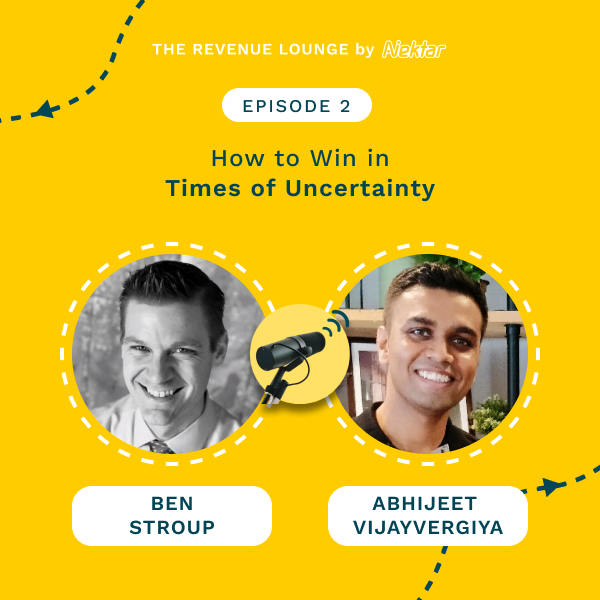
Ep #2: How to Win in Times of Uncertainty
Listen Now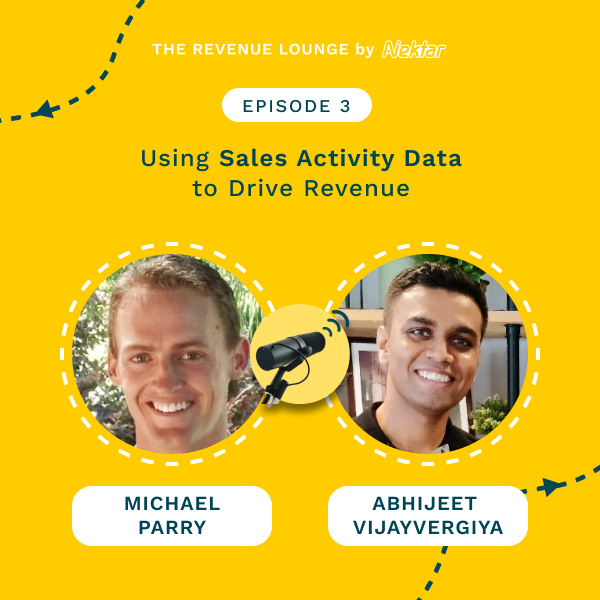
Ep #3: Using Activity Data to Drive Sales Productivity
Listen Now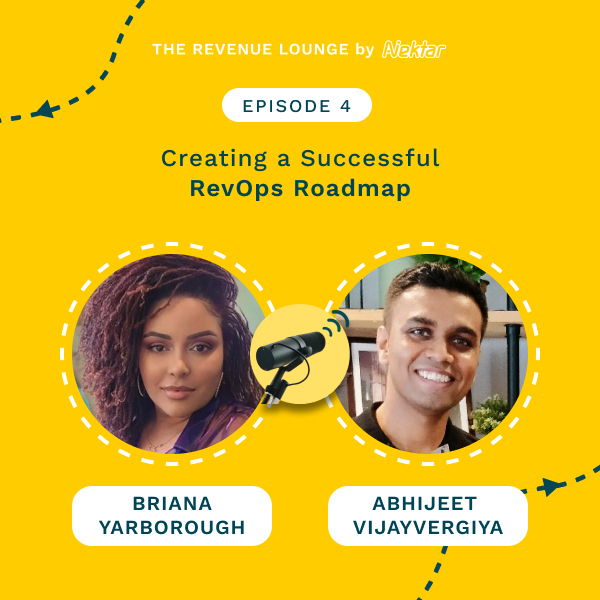
Ep #4: Creating a Successful RevOps Roadmap
Listen Now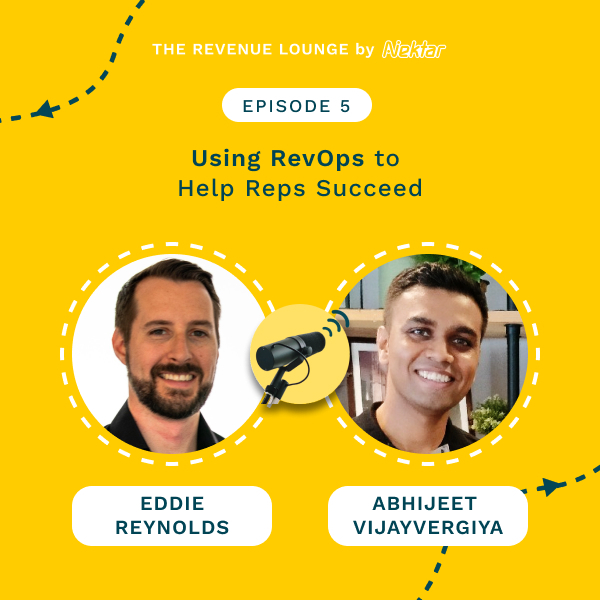
Ep #5: Using RevOps to Help Reps Succeed
Listen Now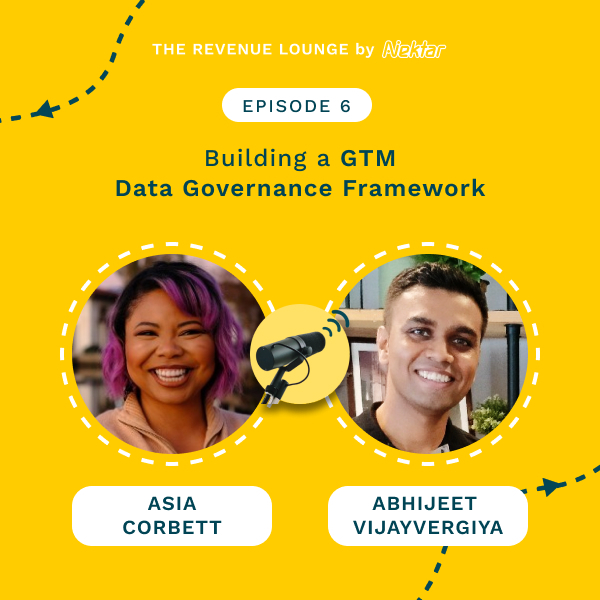
Ep #6: Building a GTM Data Governance Framework
Listen Now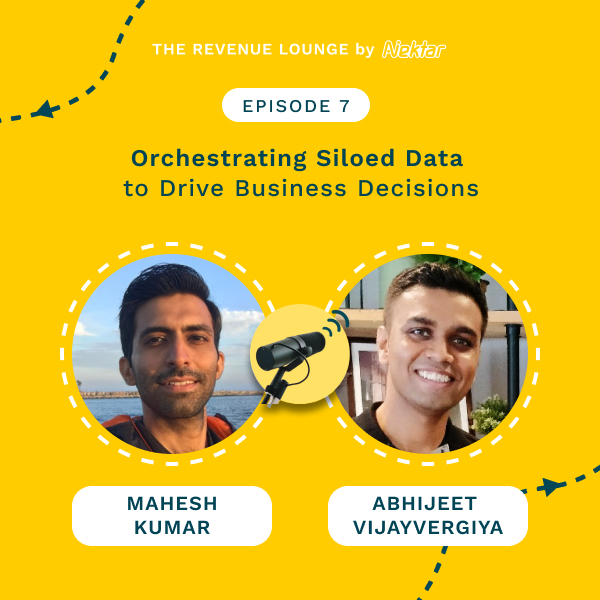
Ep #7: Orchestrating Siloed Data to Drive Business Decisions
Listen Now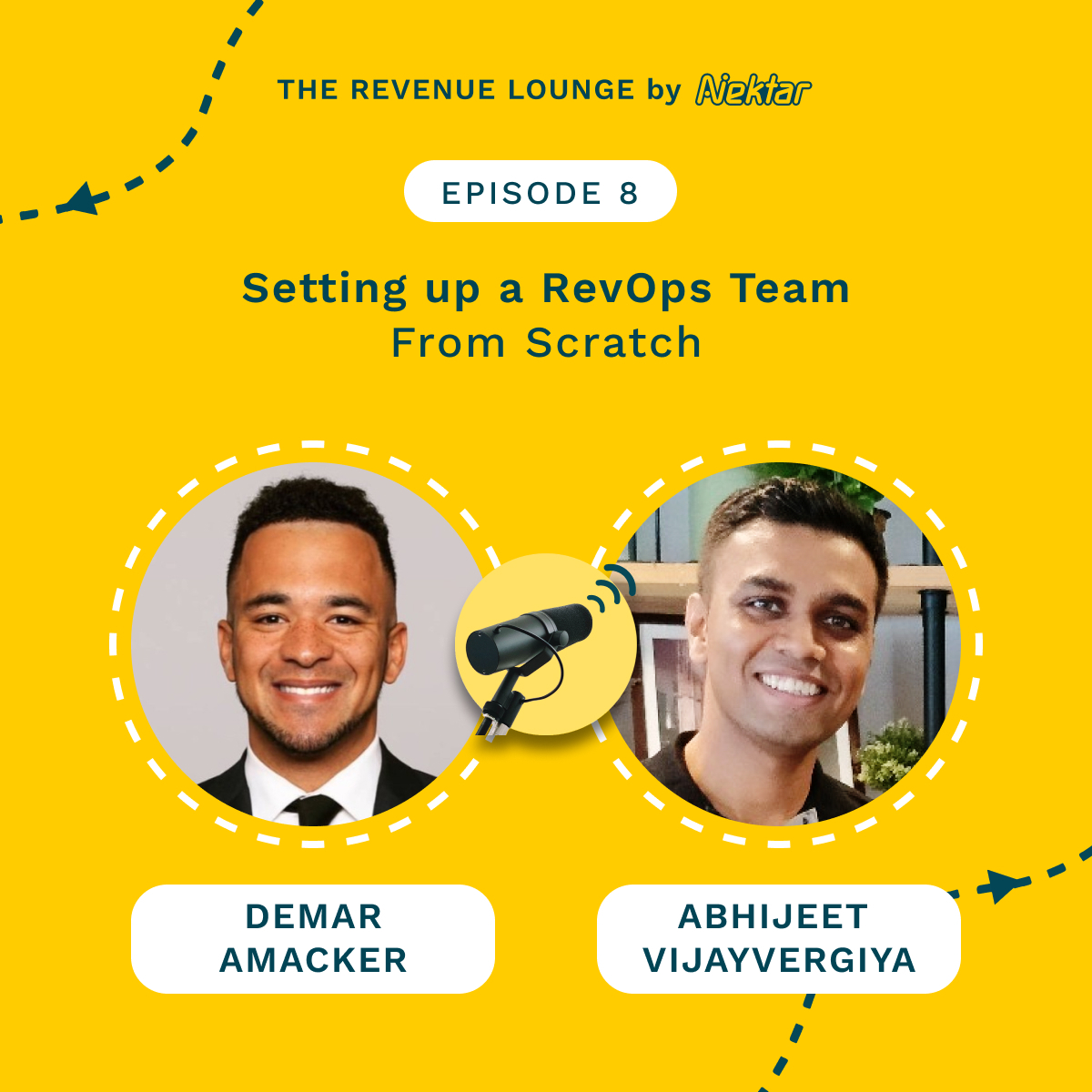
Ep #8: Setting Up a RevOps Team From Scratch
Listen Now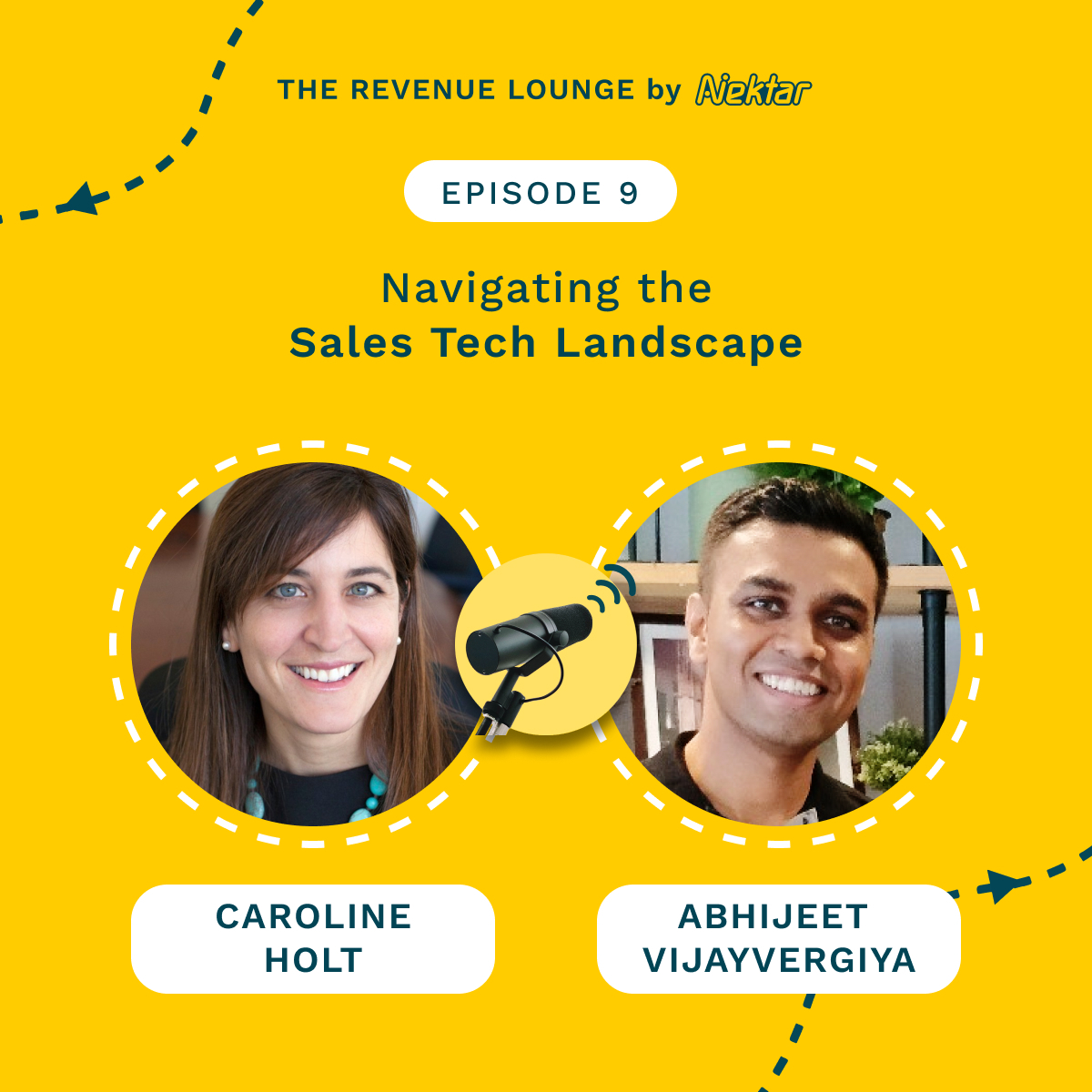
Ep #9: Navigating the Sales Tech Landscape
Listen Now